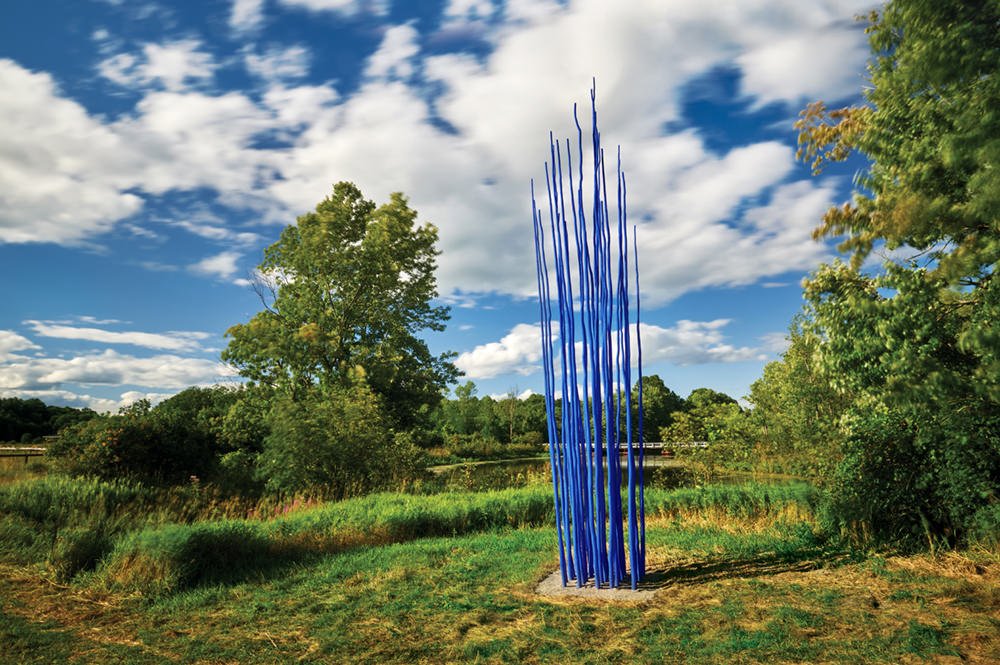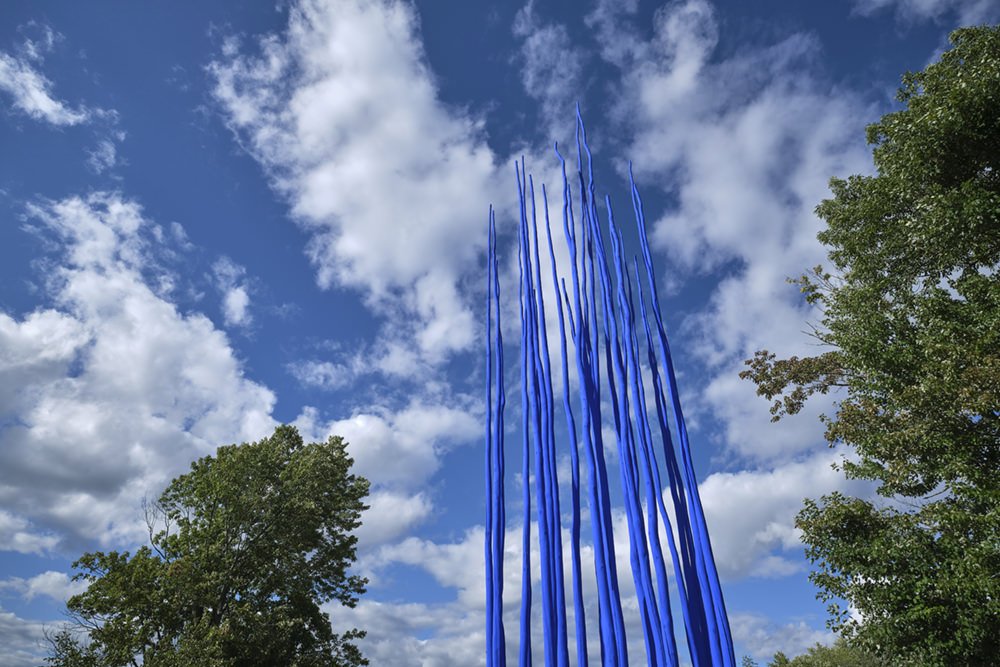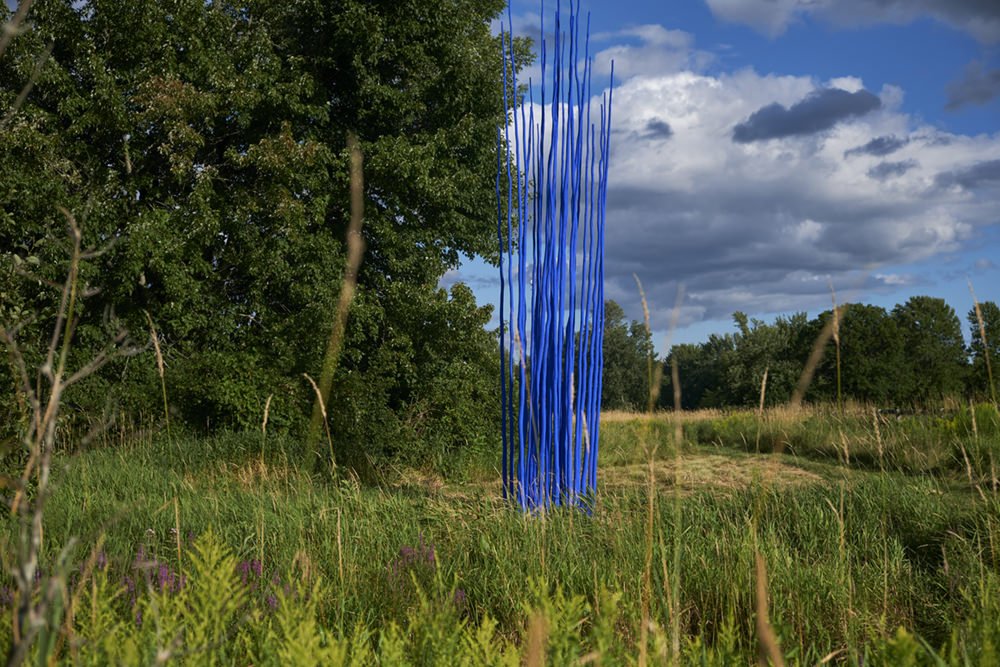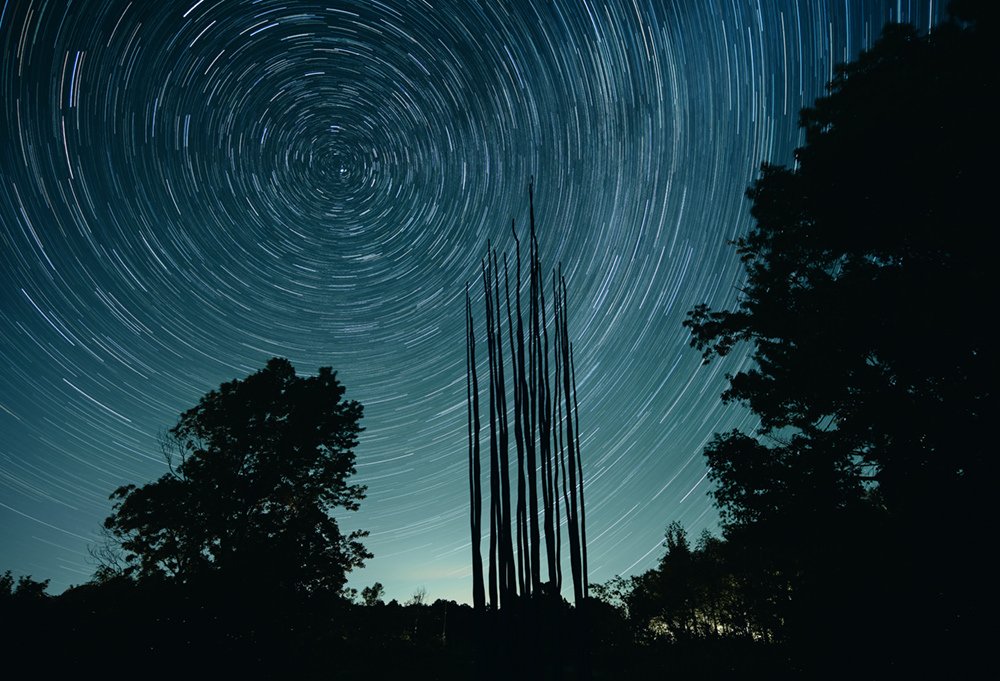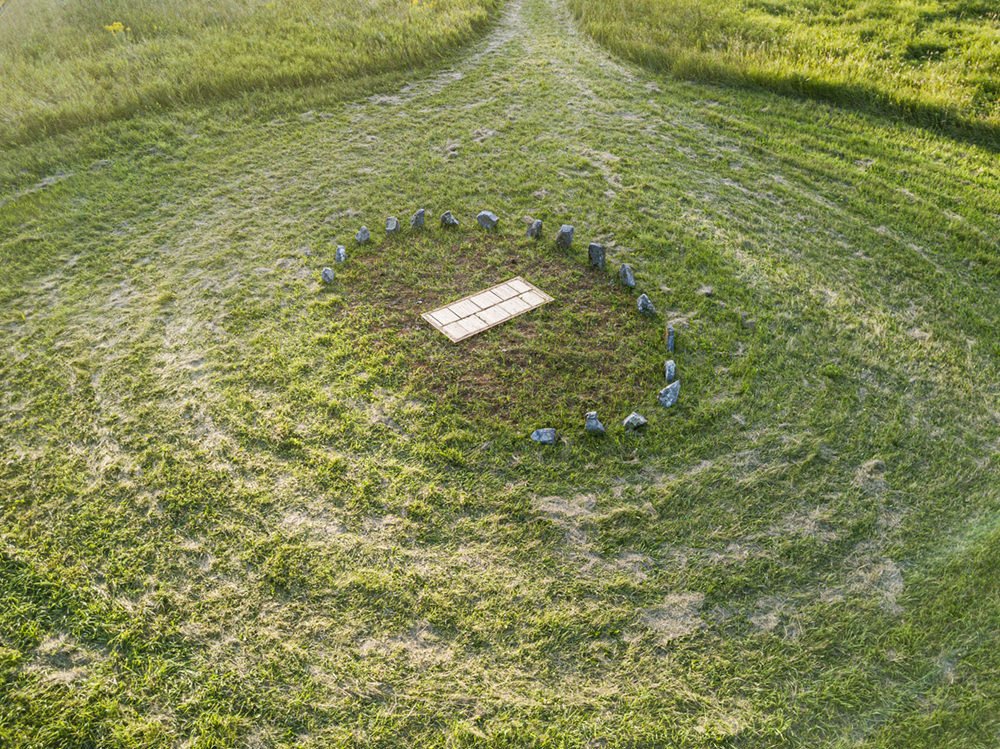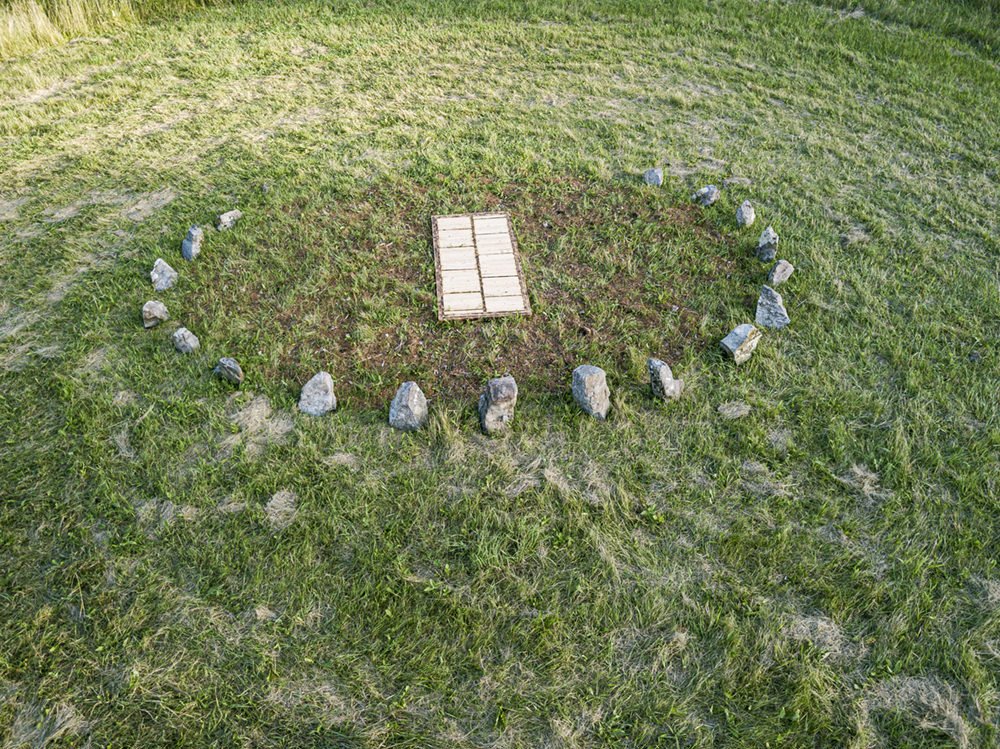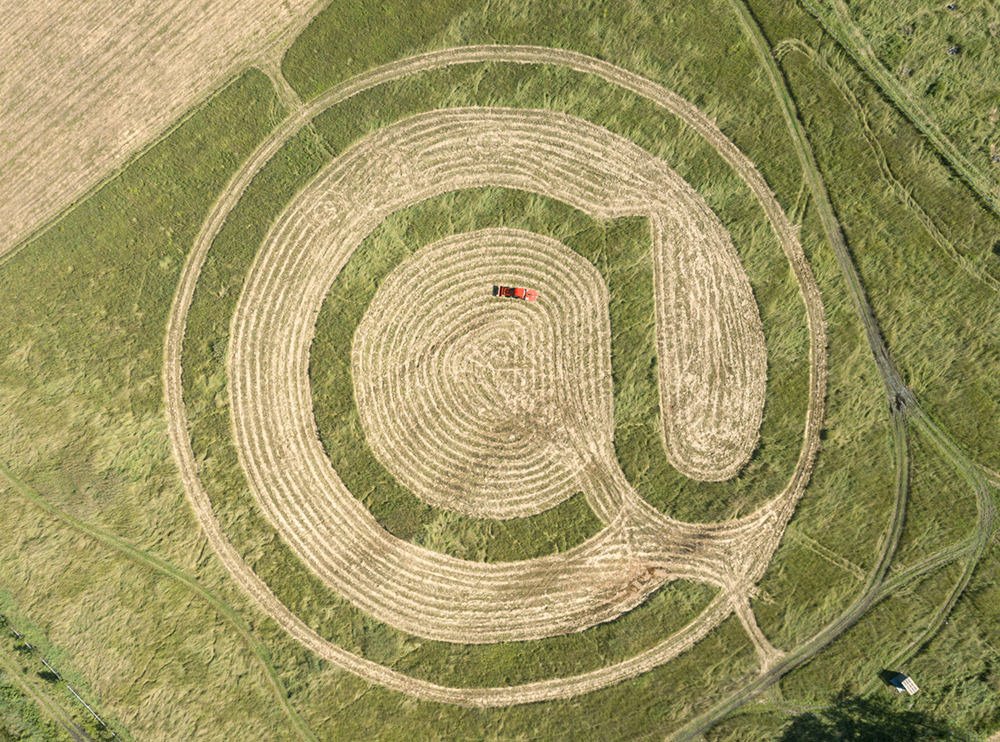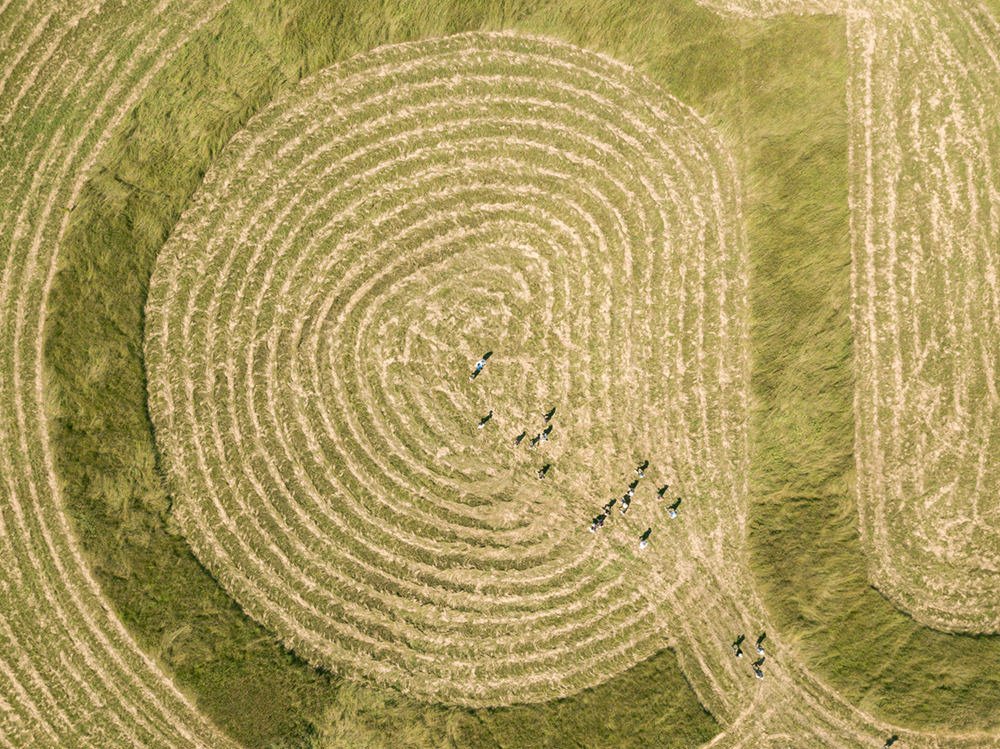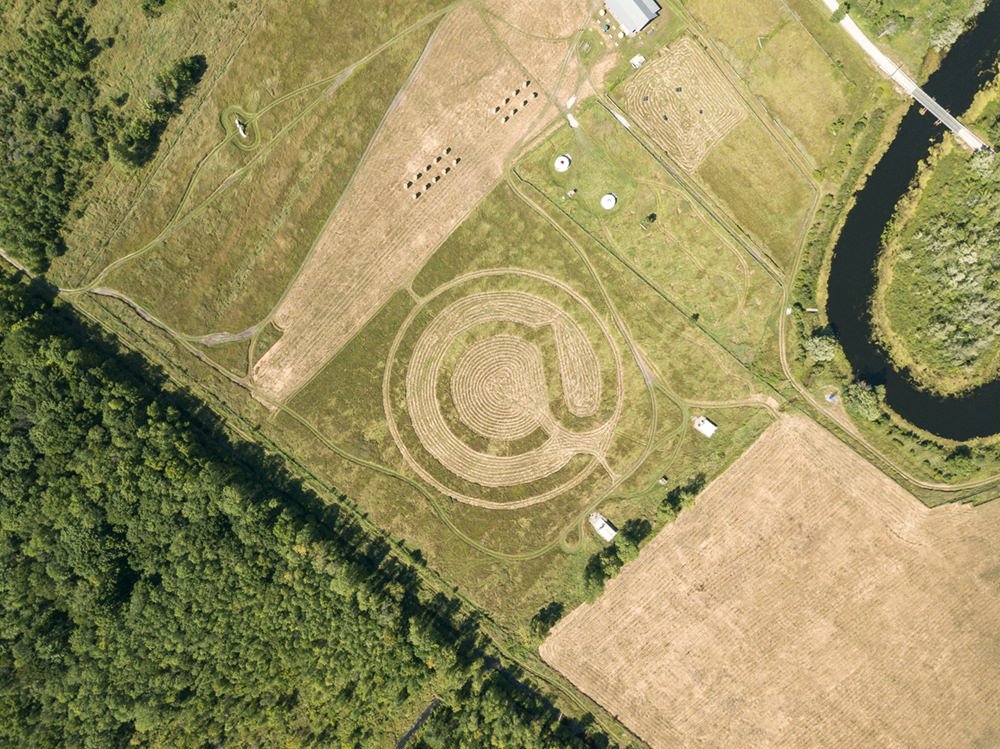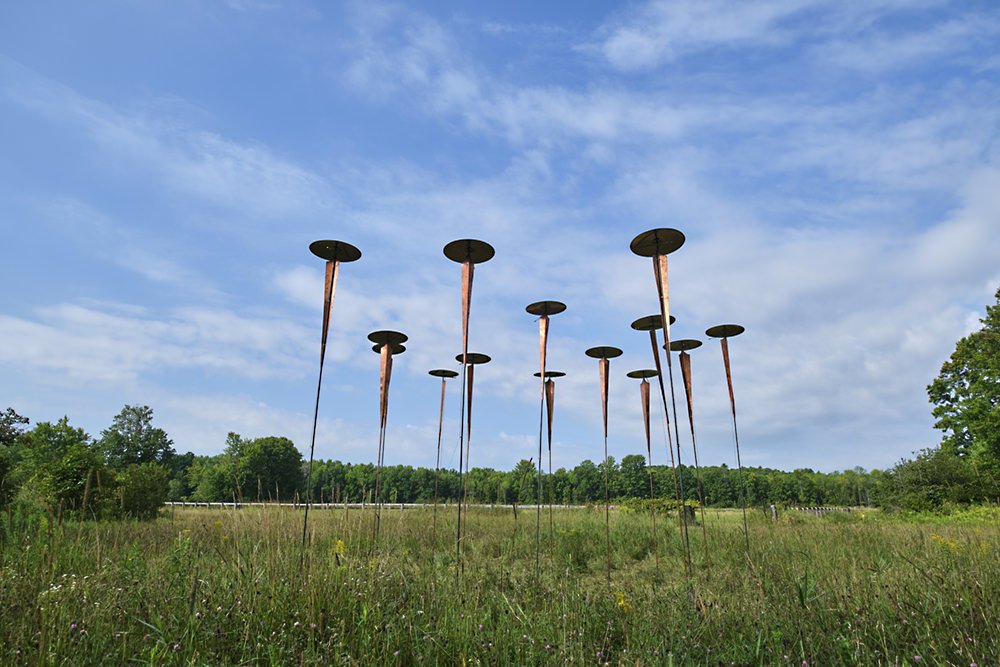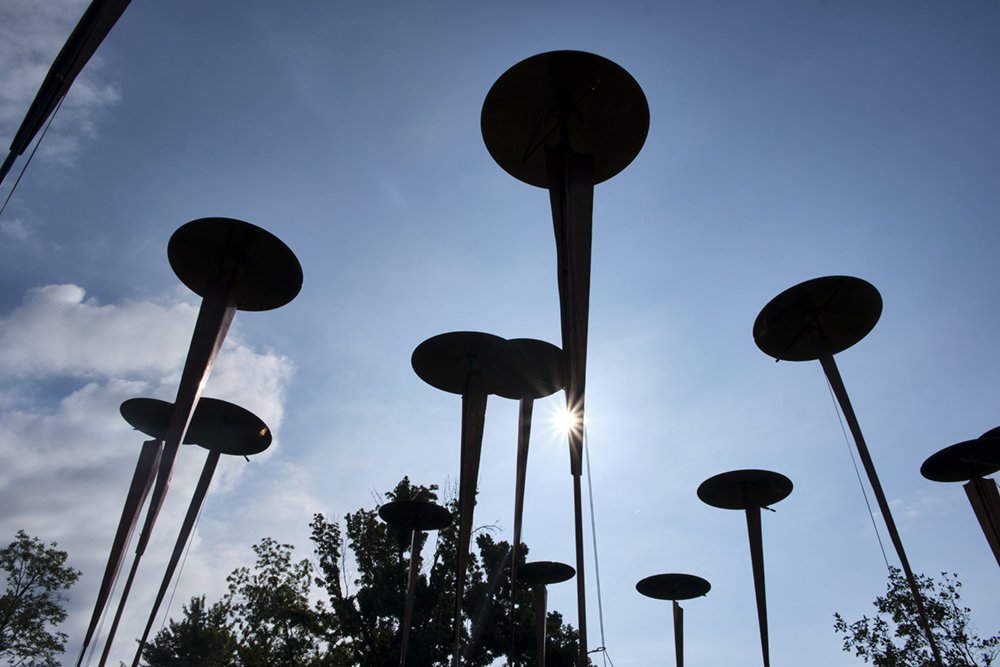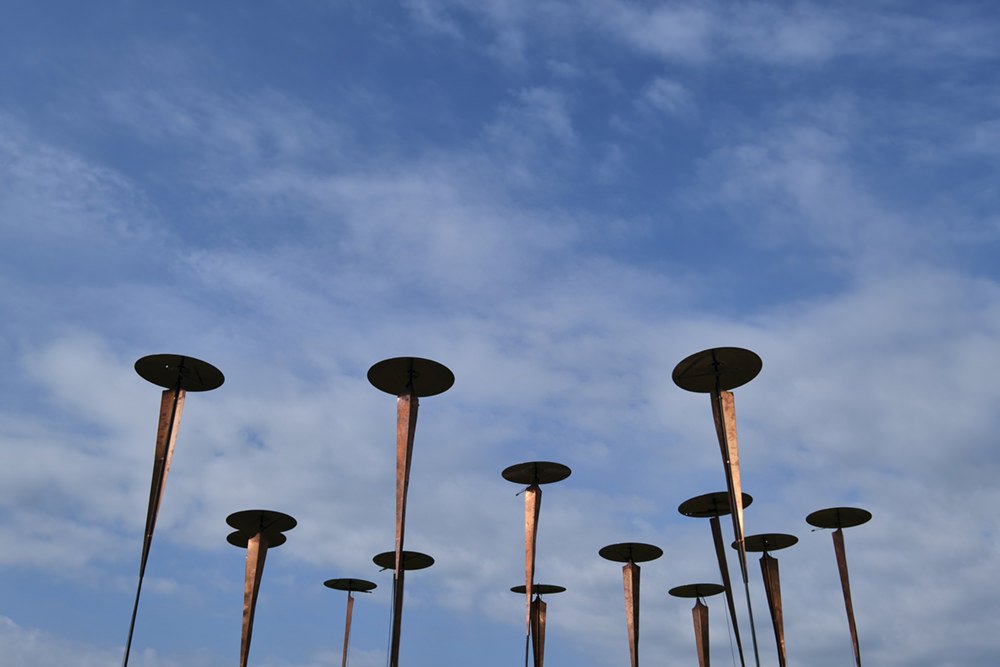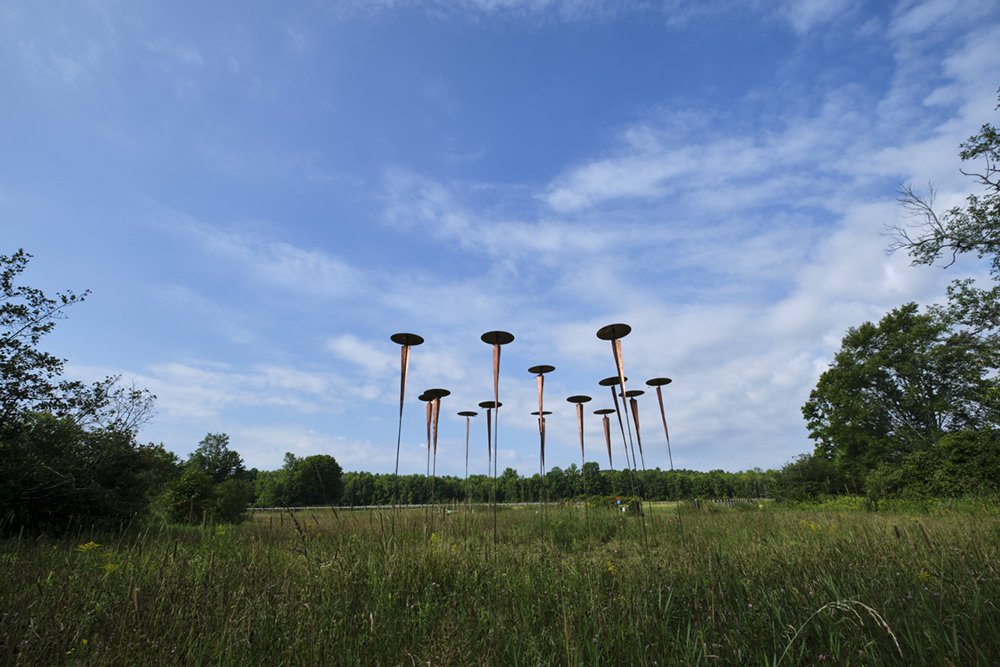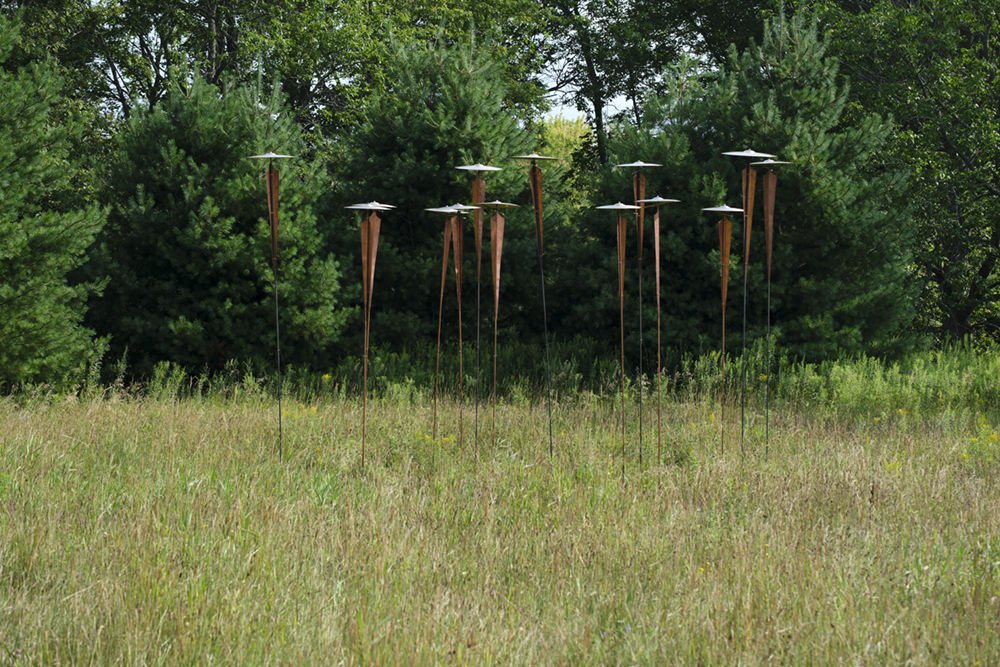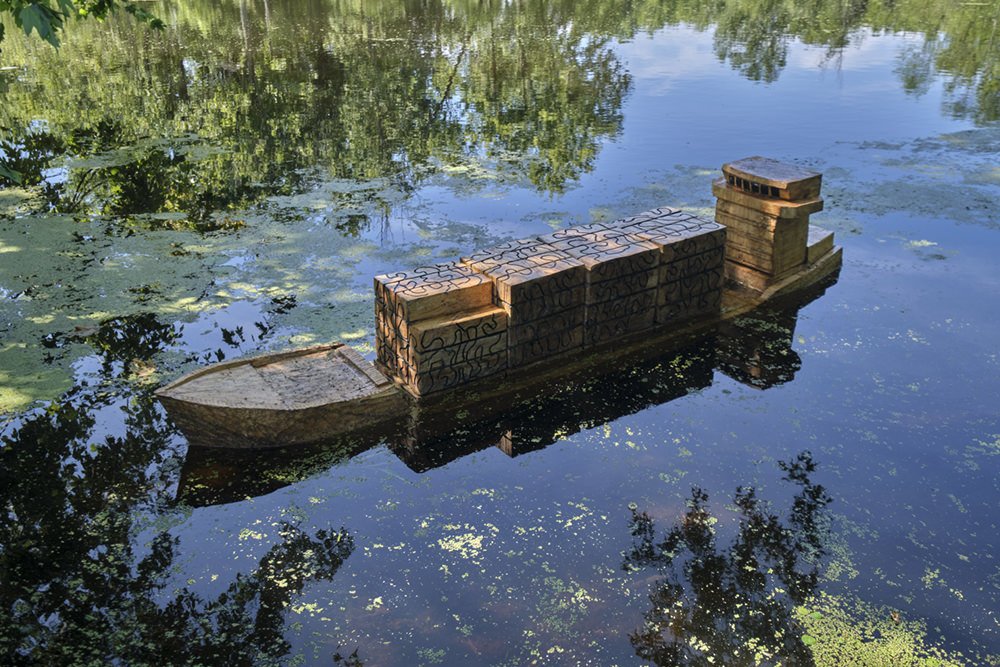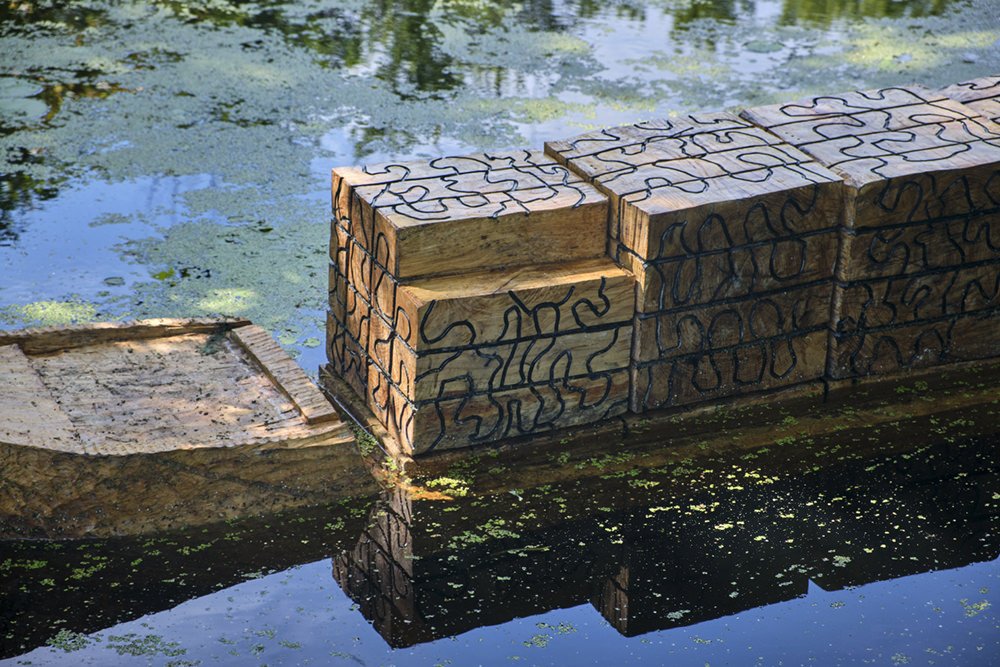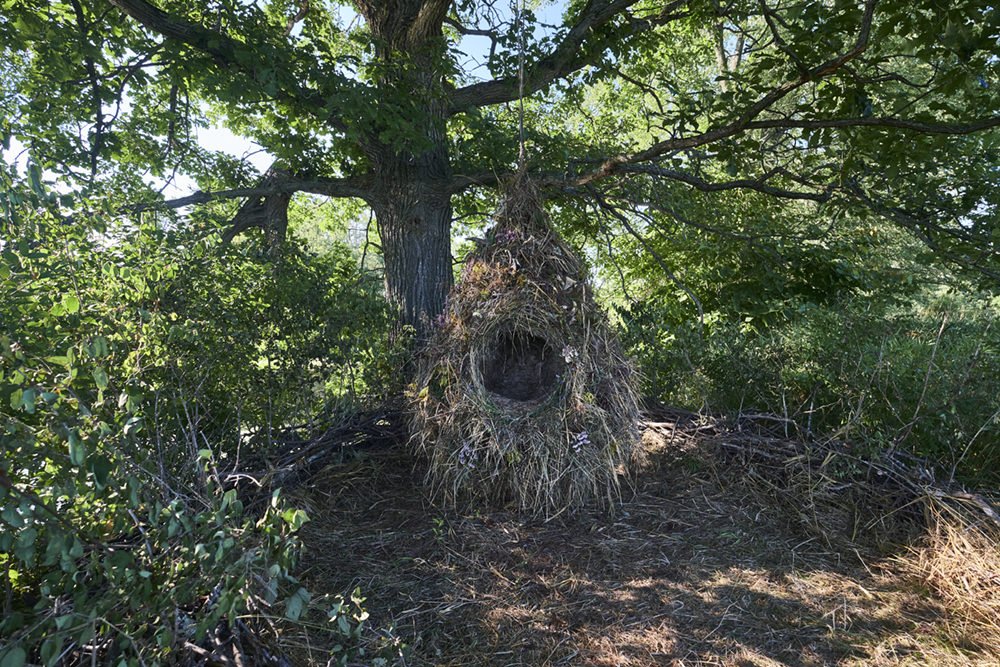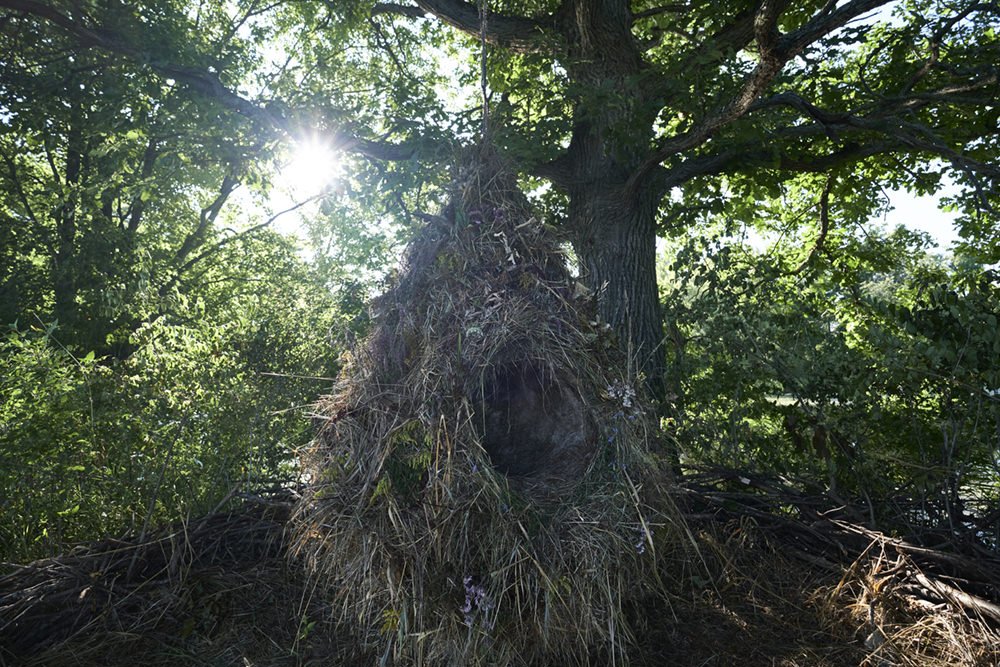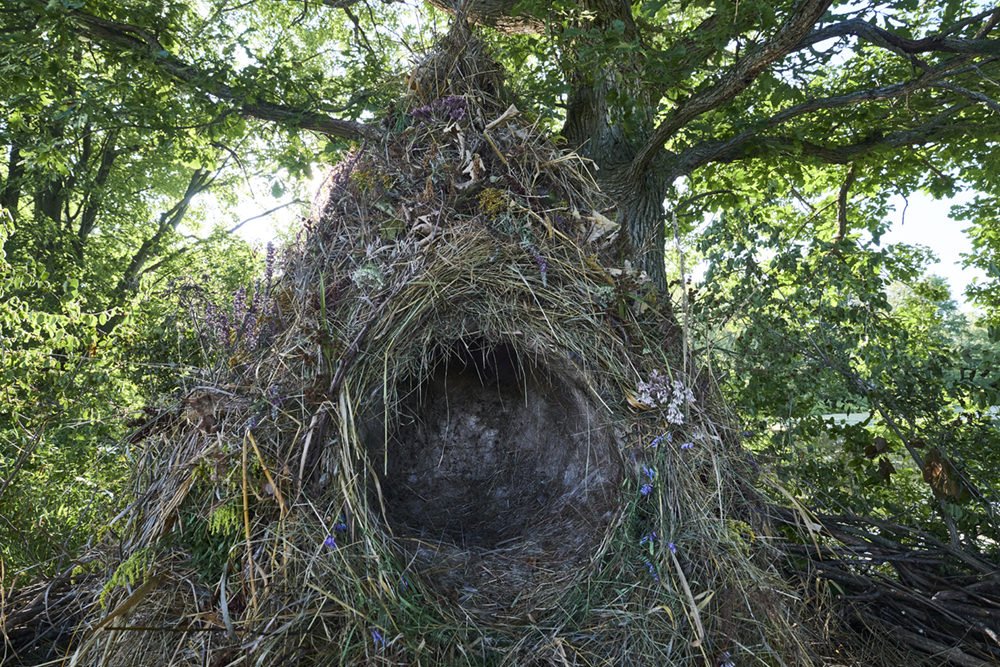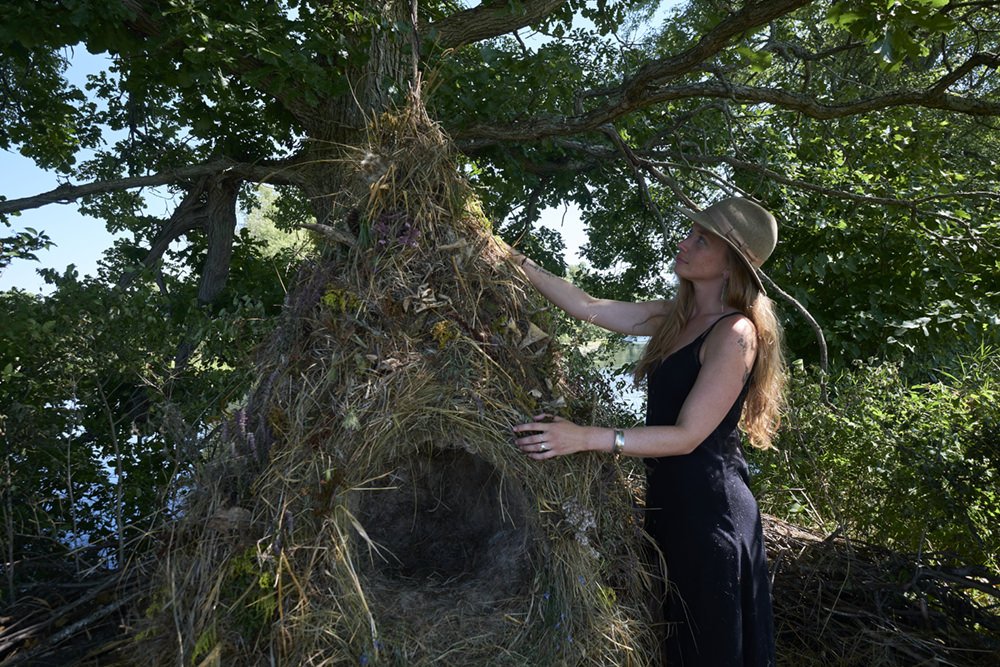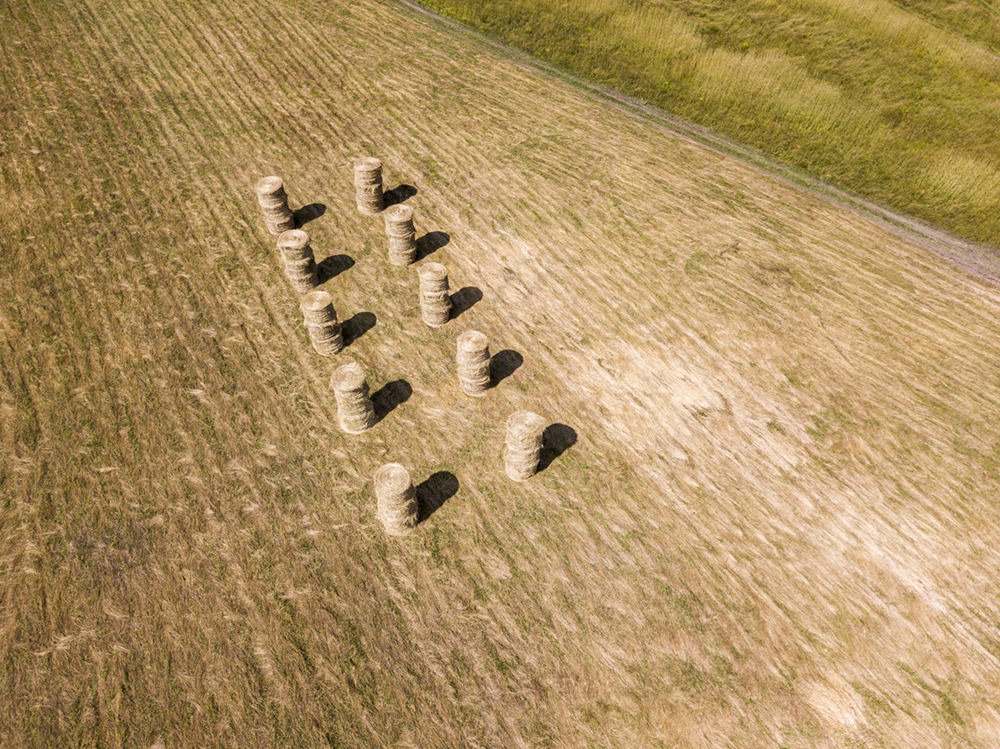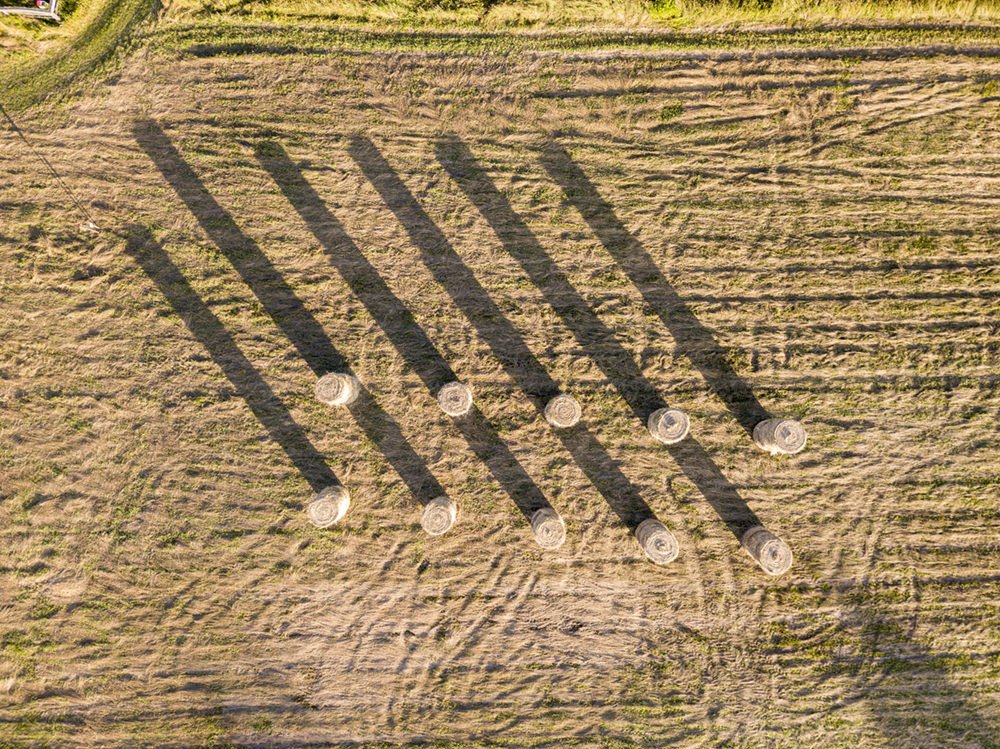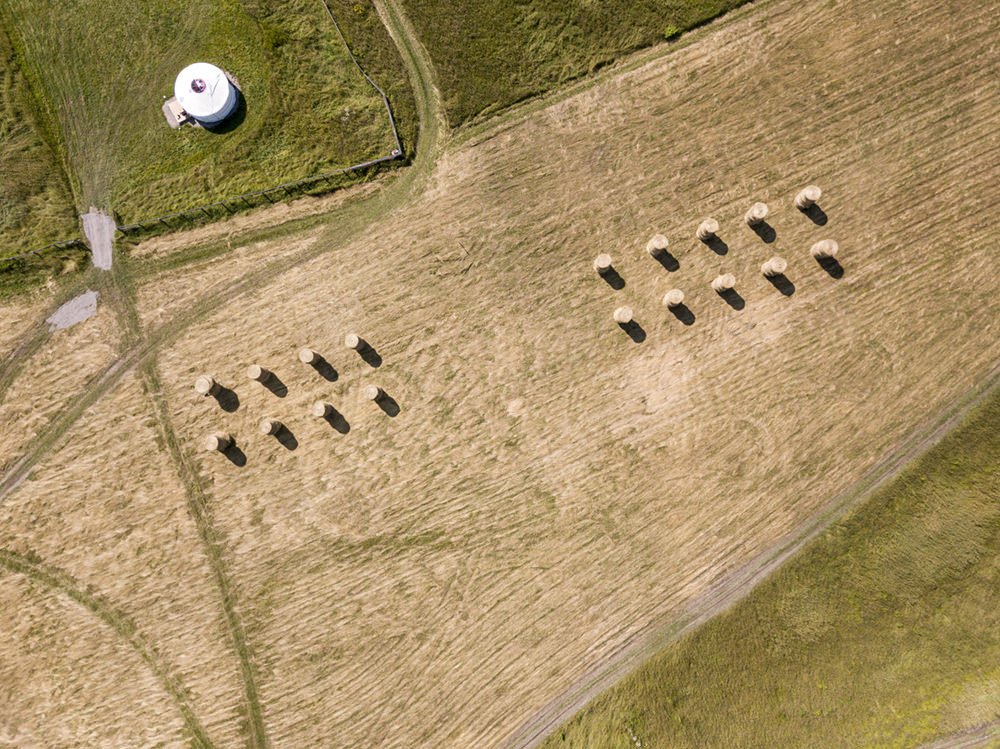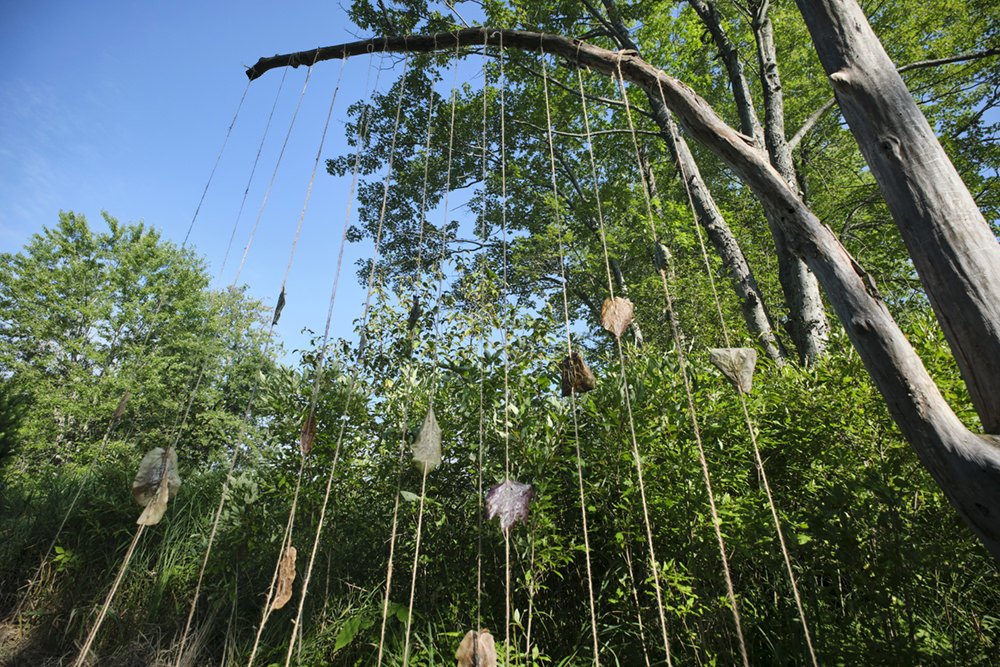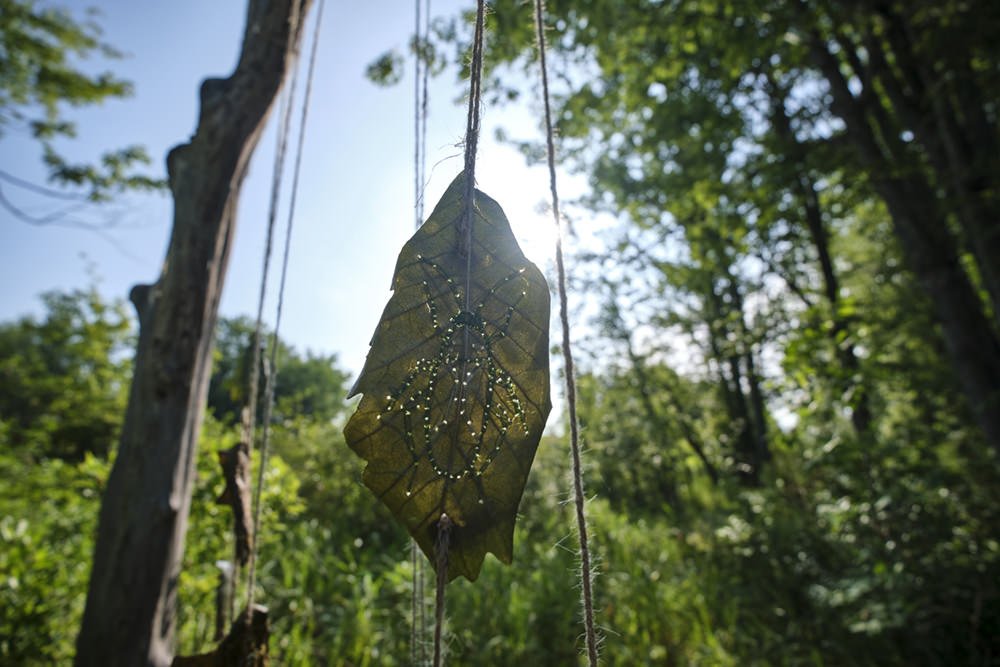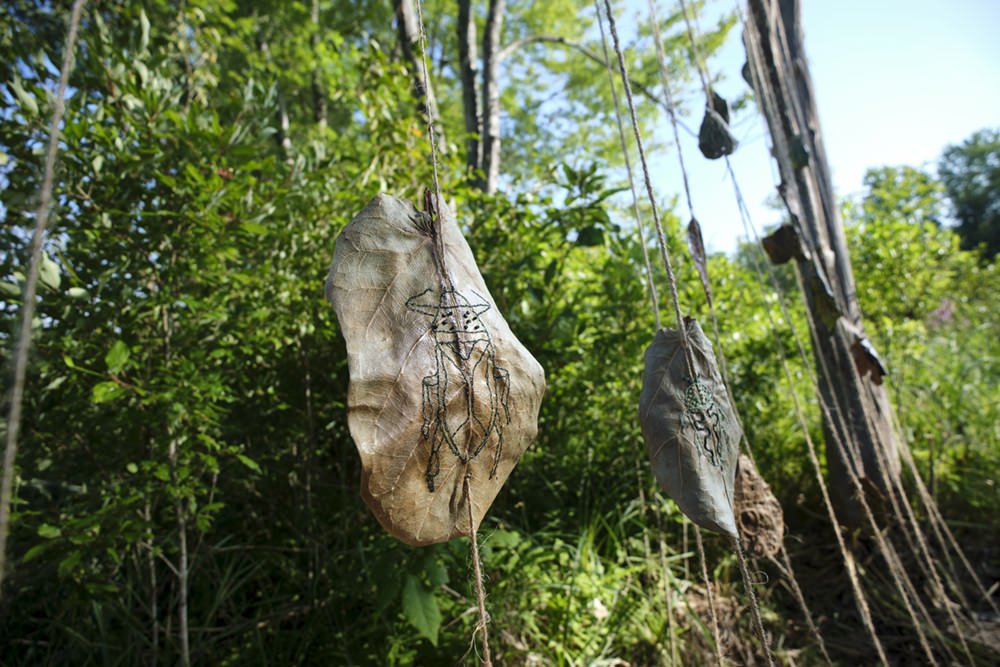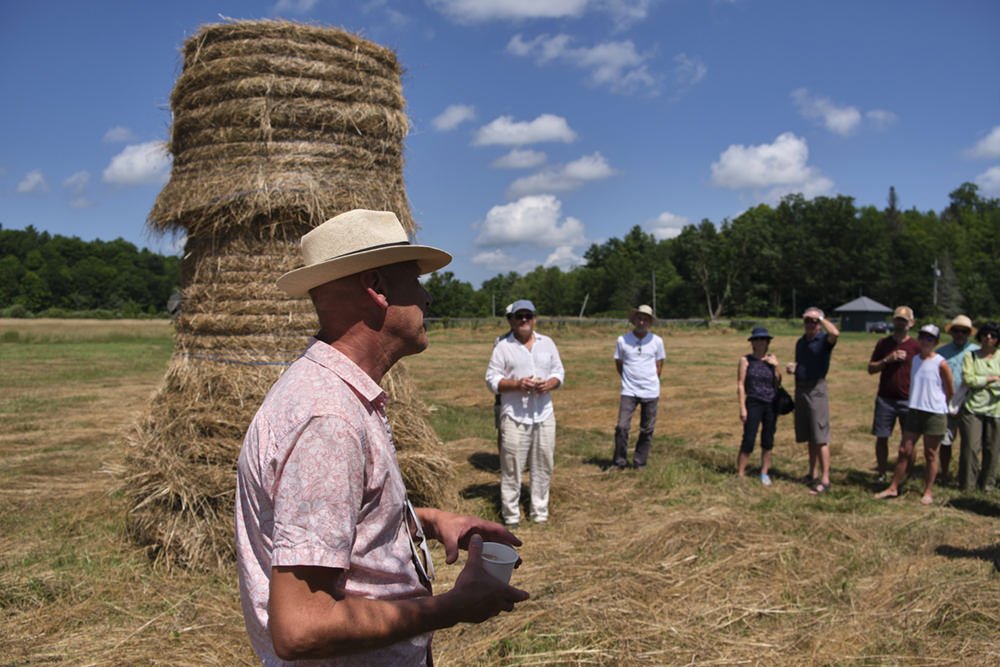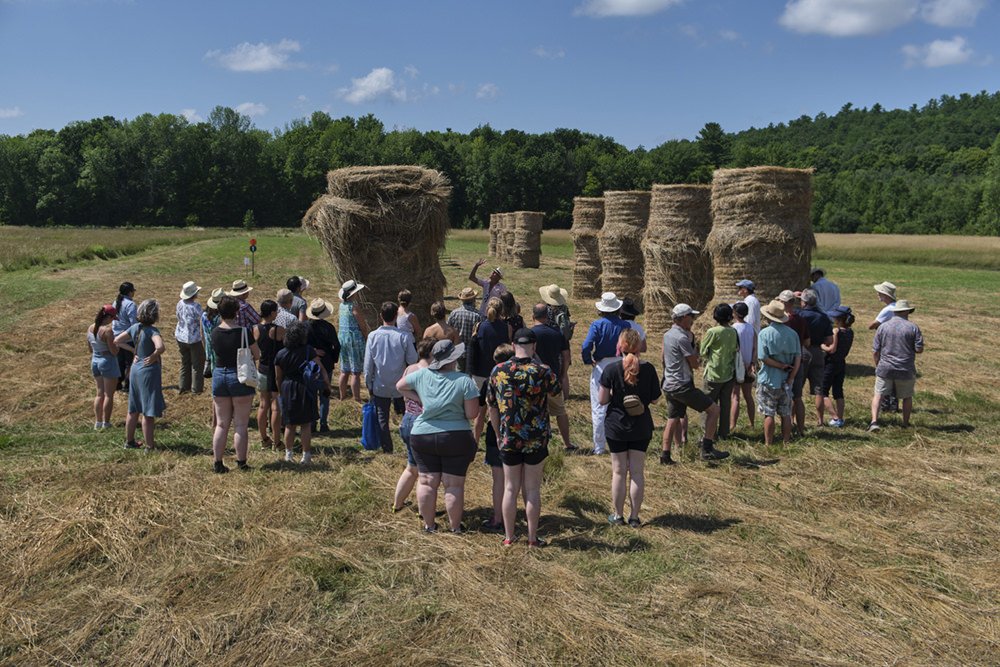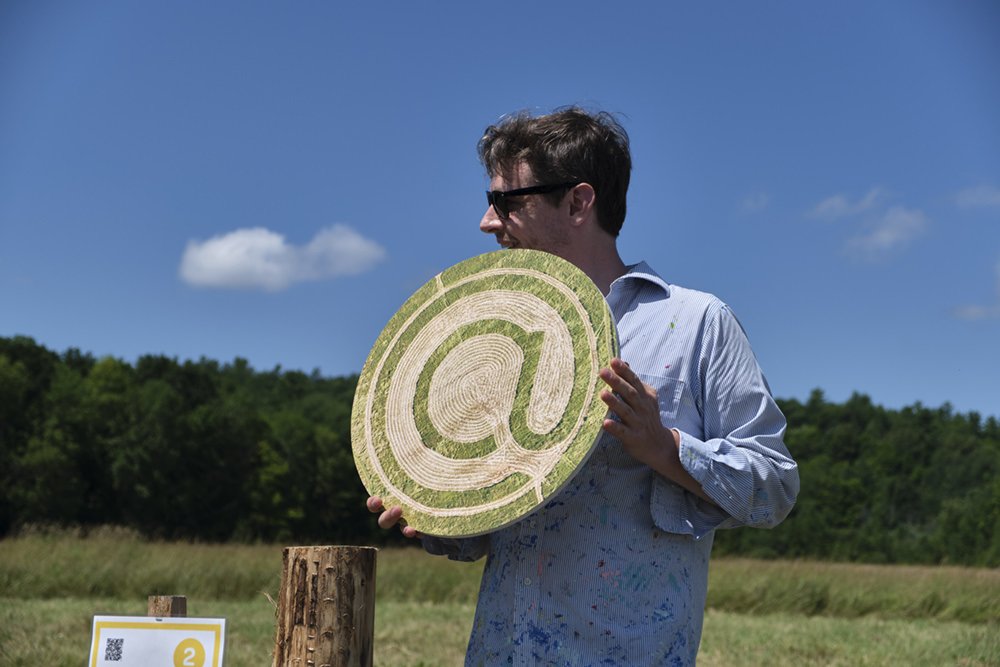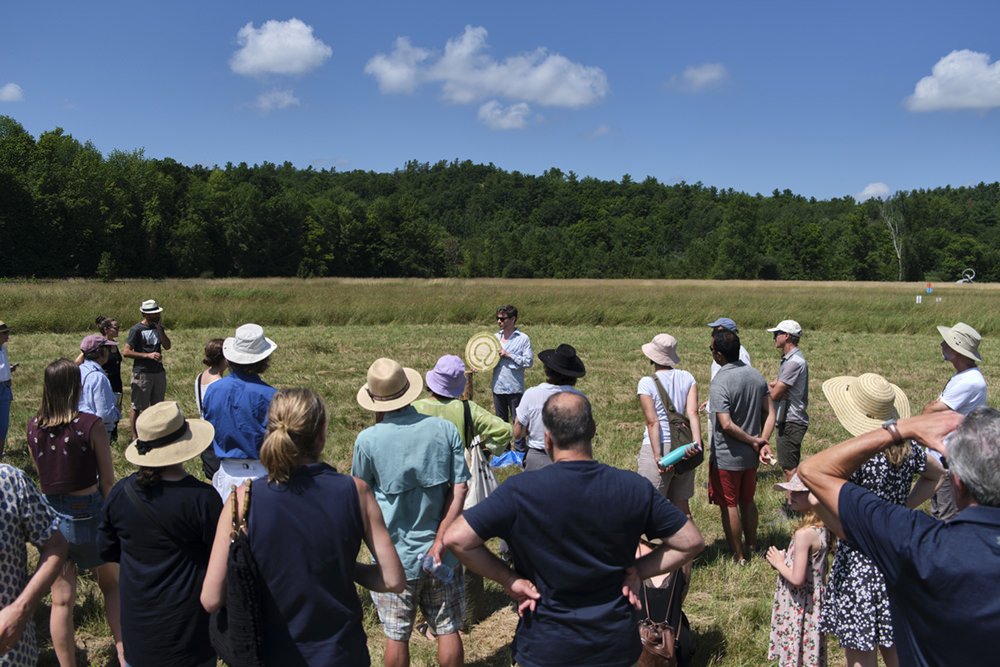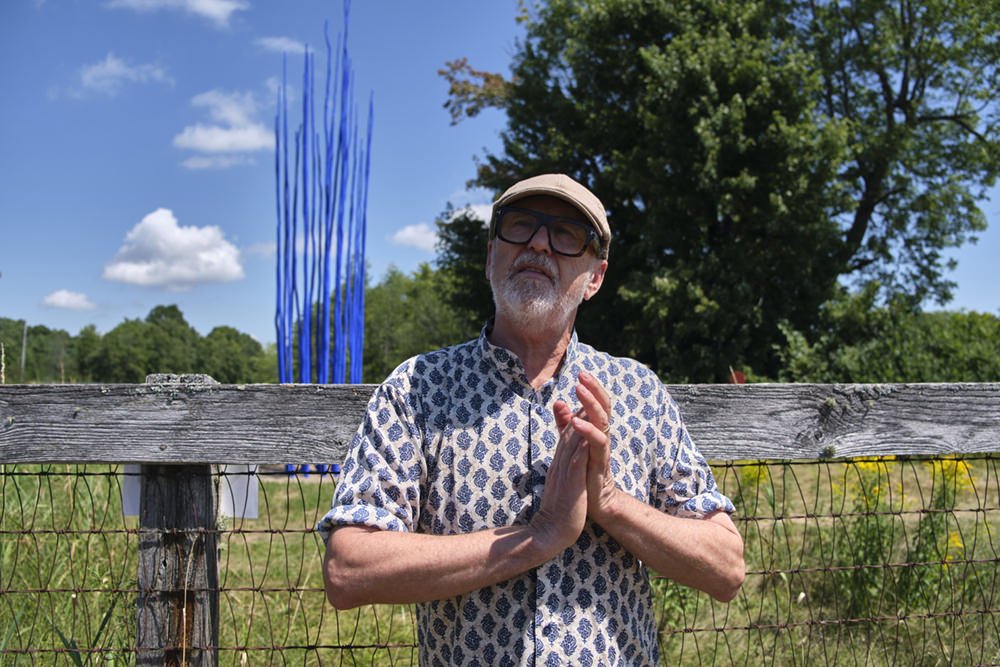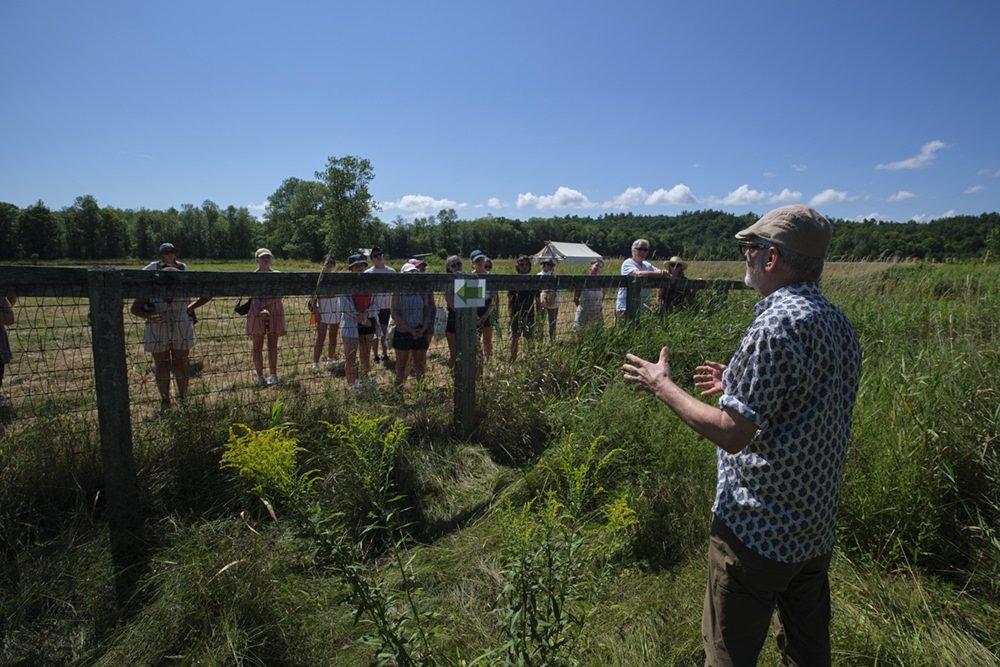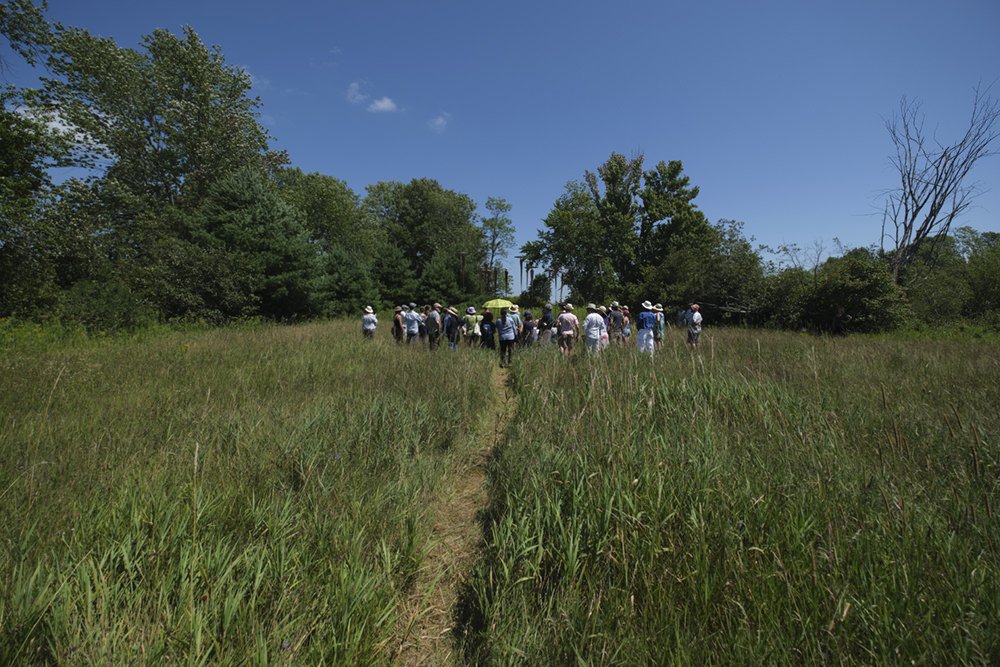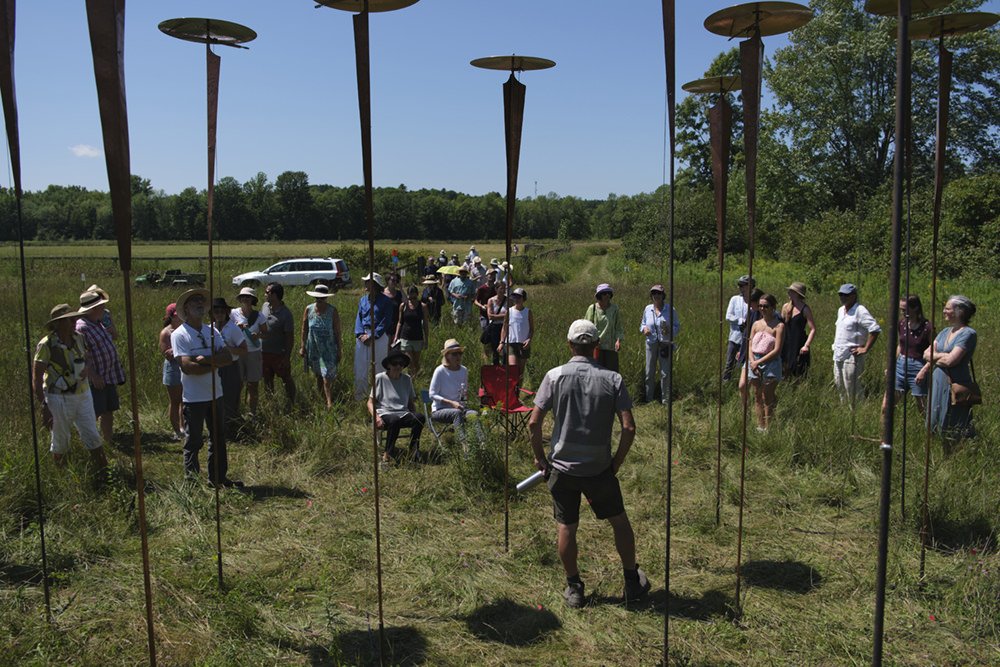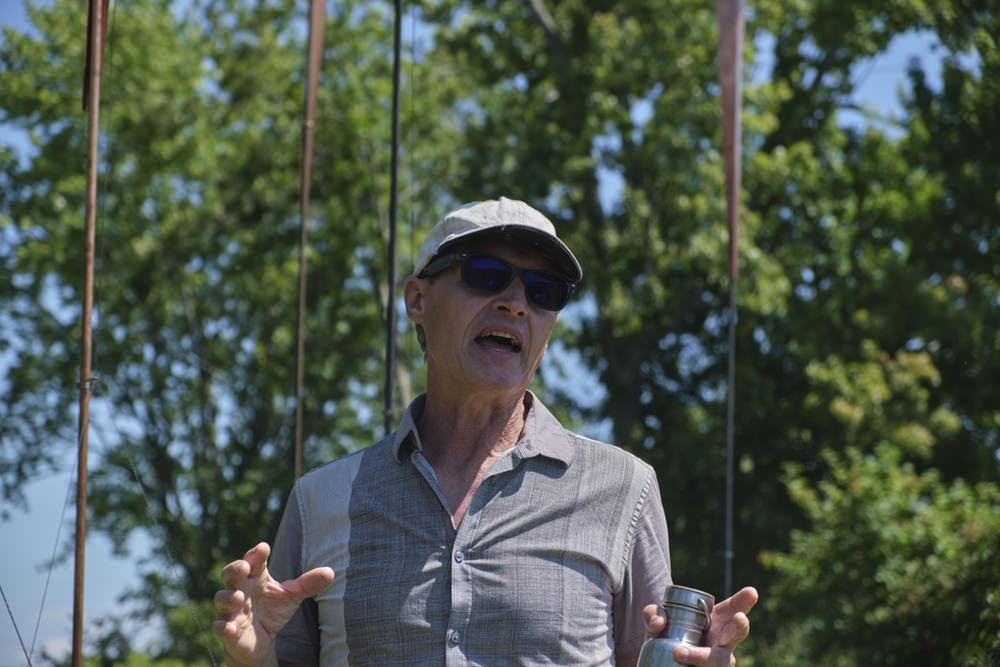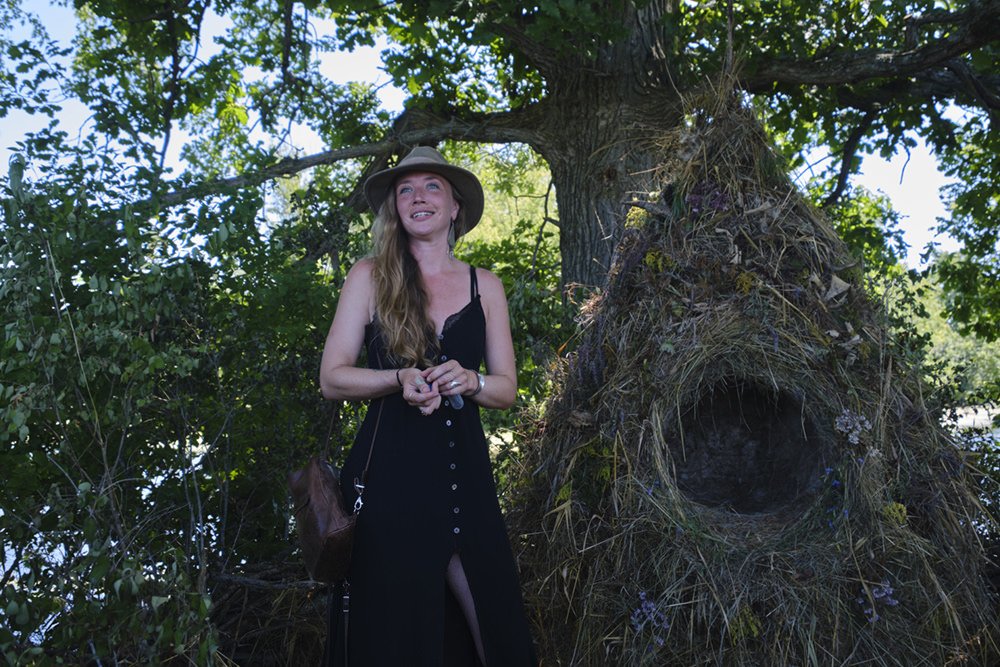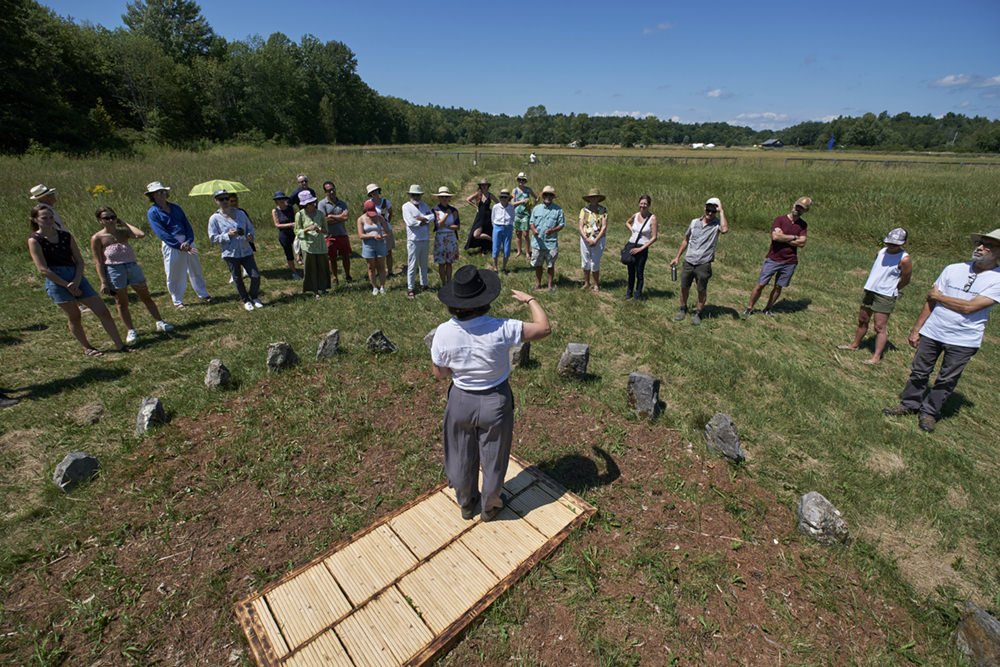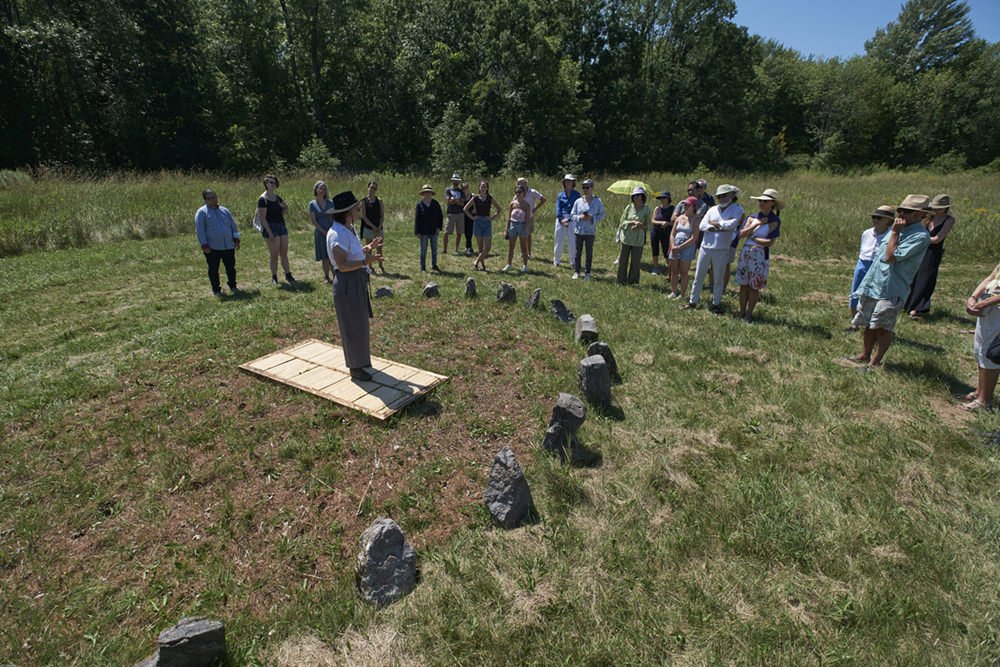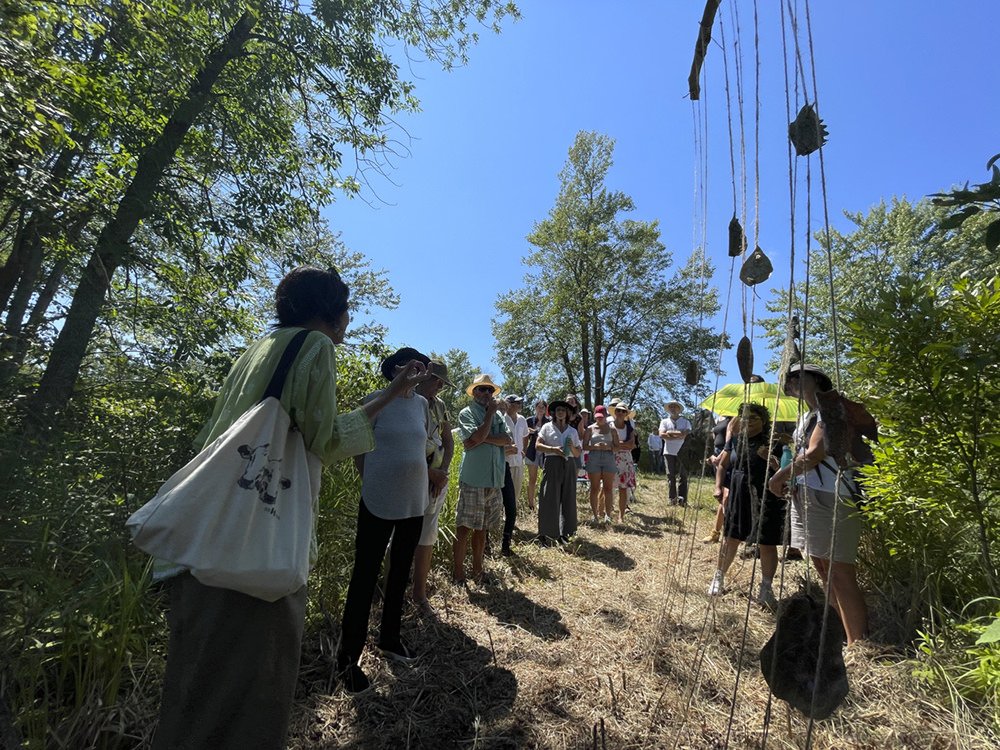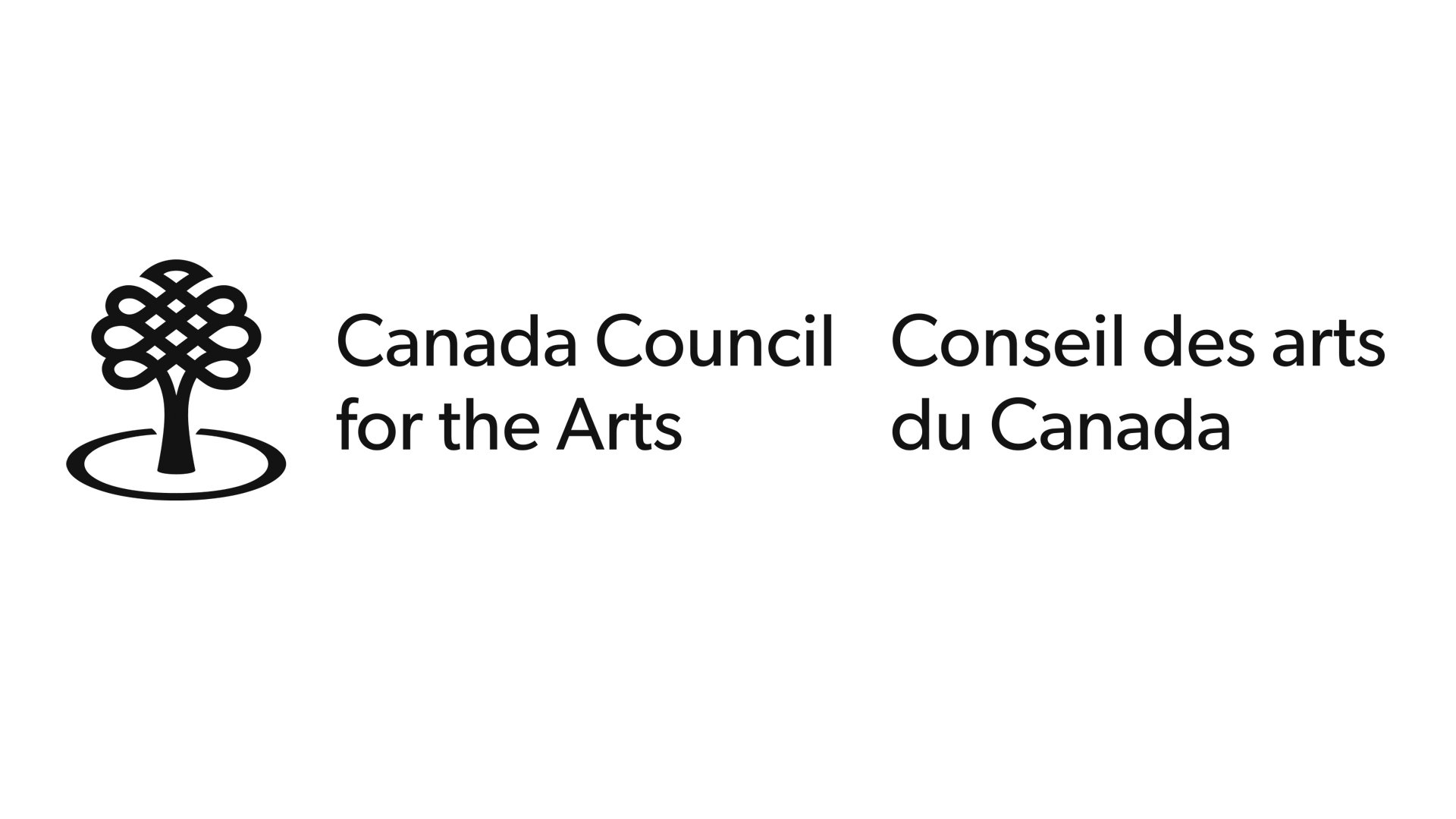Shayne Dark, Into the Blue
2022 Eco-Art Exhibition
At No.9 Gardens
August 7 – September 25, 2022
Celebrated Canadian artists have been commissioned to create art installations at No.9 Gardens that speak to their natural surroundings.
These creative works will populate the lush forest trails, golden wildflower fields, and tranquil wetlands surrounding No.9 Gardens. The works will be available for visitor viewing during our operation hours, and we will be hosting guided tours during the weekends. In addition to these tours, we will also be hosting art, sustainability, and education workshops suitable for all ages. The Eco-Art exhibition will take visitors on an exploratory art walk into nature while also providing meaningful programs and workshops that bring people and communities together.
Shayne Dark
Into the Blue
Into the Blue, is a site-specific installation originating from Dark’s “Habitat” series. In this series he explores the ephemeral natural process of growth and decay. The poles are drenched in a dense theatrical paint that absorbs light and reveals the striking subtleties and natural beauty in the wood.
Shayne Dark is a Kingston, Ontario based contemporary visual artist whose work often evokes the contrasts between urban settings and the natural world, and is meant to stimulate a spiritual or visceral reaction in the viewer. He has exhibited widely both nationally & internationally. Shayne transforms ordinary materials such as aluminium, glass, lead, steel ball bearings, and wood into atmospheric and thought-provoking installations. Fueled by his interest in the variance between the urban and natural world, Dark states that his work is meant to “stimulate a spiritual or visceral reaction in the viewer.” His work prizes nature as inspiration for his abstract and colourful forms. Poised between abstraction and representation, the artworks of Canadian artist Shayne Dark are often coated in eye-popping saturated pigments. His networks of steel branches or steel stones, indoor and outdoor iterations, are a contemplative intersection of the industrial and the organic.
Christine Dewancker
Analemmatic Sundial
This analemmatic sundial places the participant as the center point, casting a shadow to project the hour line. The gnomon must change position depending on the time of year to accurately indicate the time of day. Centuries of mathematical and geographic discovery have contributed to the knowledge needed to create this sundial and as your shadow is cast, I invite you to consider not only the time, but the history of these knowledge systems.
Christine Dewancker is an artist currently living in Toronto, Canada. Through her work, she explores the physical and psychological effects of the spaces we occupy and how the built environment informs our experiences and relationships with each other. Christine is interested in systems of production and circulation and how these conditions influence our relationship to materials and place. Much of her work is site specific, responding to the environment in which it is situated and is informed by the historical, socio-economic, and ecological conditions that produce the places we inhabit.
Sean Martindale
where It’s @
A playful nod to land art, crop circles, and pop culture, where it’s @ probes our shifting relationships with language, nature, technology, and perception. Where are the boundaries between literal (singular, physical) sites, functional (conceptual, discursive) sites, and digital sites? The giant @ symbol, visible from satellites, highlights our shared address: Earth.
Martindale’s @ is a looping 7.62m (25ft) thick band of overgrowth and wild flora in an otherwise mowed hay field. Further, a square swath around its circumference has been left untouched, rather than being baled as usual. These uncut areas are semi-re-naturalized and provide habitat for local fauna.
Sean Martindale is an internationally recognized and award-winning interdisciplinary artist and designer based in Toronto, Canada. His interventions activate public spaces to encourage engagement and often focus on ecological and social issues. His playful works suggest alternate possibilities for existing spaces, infrastructures, and materials found in urban environments. Frequently, Martindale uses salvaged goods, and live plants in unexpected ways that prompt conversation. Martindale’s projects have been featured on countless prominent websites and in traditional media such as print, radio, broadcast television, and film. His practice has a global following and has been written about in countries all over the world, in multiple languages. Martindale was profiled for the first episode of CBC’ Great Minds of Design, one of his lectures was filmed by TVO for their Big Ideas series, and his work was included in the feature-length documentary This Space Available, released in 2011.
John Dickson
Anenomes
Anenomes consists of a grouping of large cymbals mounted on flexible rods. As they move in the wind, pulley mechanisms cause drum sticks to strike the undersides of the cymbals. They are responsive to their environment, the sound increasing with the intensity of the wind.
Although all the main components are made of metal and there is a mechanical component, Anenomes has a very organic character. They resemble mushrooms, but are also reminiscent of the swaying of bamboo and grasses, or the movement of underwater plants. It is a hybrid, a harmonious balance of the synthetic and the natural.
John Dickson is a Toronto-based artist whose mixed-media sculptures and installations explore humanity's tenuous relationship with the natural world. Early works investigated water as a sculptural medium, leading to the development of themes with underlying environmental concerns. He is particularly interested in working in non-gallery situations which has led to his involvement with collective projects such as NetherMind, and Persona Volare, and alternative venues such as the Tree Museum. Past projects include a recently completed series of permanent sculptural works for Downsview Park in Toronto, Frontier, a public commission for the West Toronto Railpath, Music Box for Toronto’s 2013 Nuit Blanche and COLD WAR at the AGO’s Young Gallery. He has shown internationally in the USA, France, the Czech Republic and Denmark.
Patrick Bermingham
Emerald B.
The “Emerald B.” represents a container ship delivering both cargo and invasive species. The emerald ash borer first arrived in the Windsor/Detroit area in 1990, traveling inside wooden packing materials. It has since spread throughout Canada and the United States destroying 99% of all ash trees in its path. The sculpture was carved from a seven meter section of an ash tree killed in 2015. The beetle’s destructive path beneath the bark (which cuts off the flow of nutrients) is etched onto the containers’ surface–reminding us that global shipping industry delivers more than just low-cost products.
Patrick Bermingham is an internationally-recognized artist whose career spans decades. With a BFA in Sculpture, Bermingham has studied with and apprenticed with several renowned artists, including Elizabeth Bradford Holbrook, Sir Anthony Caro, and Tim Scott. Bermingham participated in the first Canadian Wildlife exhibition in 1974 together with Robert Bateman and A.J. Casson. Bermingham frequently travels to Chile to work in the studio of Francisco Gazitua, whose large scale public installations and sculptures can be seen in multiple countries, including three iconic public sculptures in Toronto and several in Chile. Bermingham has exhibited his work in the United States and Canada and recently completed a commission for the International Operating Engineers Union, Local 793, and created a memorial garden honouring the over 30 fallen members of the union.
Yolanda Weeks
Nomadic Nest
Yo is an installation artist, community arts facilitator, and art director out of Montréal/Tiohtià:ke. Rooted in land art and fiber arts, she forages, sources and needle felts natural materials into large scale creations. Yo’s Nomadic Nest installation and performance series contemplates constructs and concepts of home, territory, security, migration, and movement. The act of cocooning herself and others in these giant nest-like ephemeral creations aims to comfort, confront and ultimately connect its inhabitants to a deeper sense of belonging (to the land, to themselves, to the world outside the warmth of these deciduous homes). These unique pieces and immersive experiences serve as a reminder to her and others to tread lightly on the land.
The artist currently nests in the Eastern Townships of Québec, Abenaki Territory, and the Lower Mainland of British-Columbia, Coast Salish Territory. Her ancestors reside in the Netherlands, Ireland, and England.
Christian Bernard Singer
Elegy for a Path
Elegy for a Path is an ephemeral architectonic installation that addresses the fleeting nature of life while lamenting the missed opportunities to repair our relationship with the natural world. An elegy is a poetic structure used to explore themes of loss and mourning, memory, love, solace, redemption and hope.
Christian Bernard Singer is best known for incorporating mosses and other living plant life with glass, clay, bronze, found objects, and video into installation-environments and land art works that turn on notions of place, memory and time-passing. The process of making these new works is contemplatively ritualistic, not only in their painstakingly laboriousness, but in how the sorting, editing, placing of these materials have become a way of activating quiet internal spaces in an otherwise chaotic world. More recently, he has been making small wall constructions with pine needles (each needle individually glued and painted). Although intimately-scaled, they still reference his search for being interconnected with living energy of the natural world and are, in particular, meant to evoke large weather phenomena – in this case, the movement of air, invisible except by the elements it moves when it travels. Singer has exhibited across Canada and in the US, has been published in over 20 catalogues and books, and his works are included in AWBZ Visual Arts Collection of Global Affairs Canada (among others).
Vridhhi Chaudhry
Unacquainted Acquaintances
OCAD U Artist in Residence
If we keep consuming the way we do, we might lose something beautiful that we never knew existed. ‘Unacquainted Acquaintances’ draws inspiration from the unworldly beings around us, the arthropods, that often go unnoticed. As one of the most misunderstood types of animals, it is important to familiarize ourselves with how compelling they are. The artist invites the viewers to really look for these hand-embroidered arthropods that may easily go unnoticed.
Vridhhi Chaudhry is an interdisciplinary researcher and artist from India, based in Toronto. She completed her master's in fine arts at OCAD U in Interdisciplinary Master’s in Art, Media, and Design. Her work is a play on whimsical translations of the unspoken, using interdisciplinary practices that mix realities and center performative art, installations, embroidery, paintings, and poetry. She draws inspiration from the unworldly beings around us, the arthropods, that often go unnoticed. She is specifically interested in the diversity of colors, forms, and behaviors of insects. As a species, we domesticate insects and exploit insect products (e.g., silk, beeswax, honey, cochineal, lacquer). Yet, we pollute or radically alter habitats in an attempt to attract, repel, or extinguish species of insects. Through her art she engages viewers in conversations and raises awareness about these unsung heroes, grounding her work in relational aesthetics.
Eco-Art Exhibition Opening – August 6th 2022
SPONSORS
This project is funded by a Regional Tourism Ontario Partnership grant, Canada Council for the Arts and City of Kingston Arts Fund.


